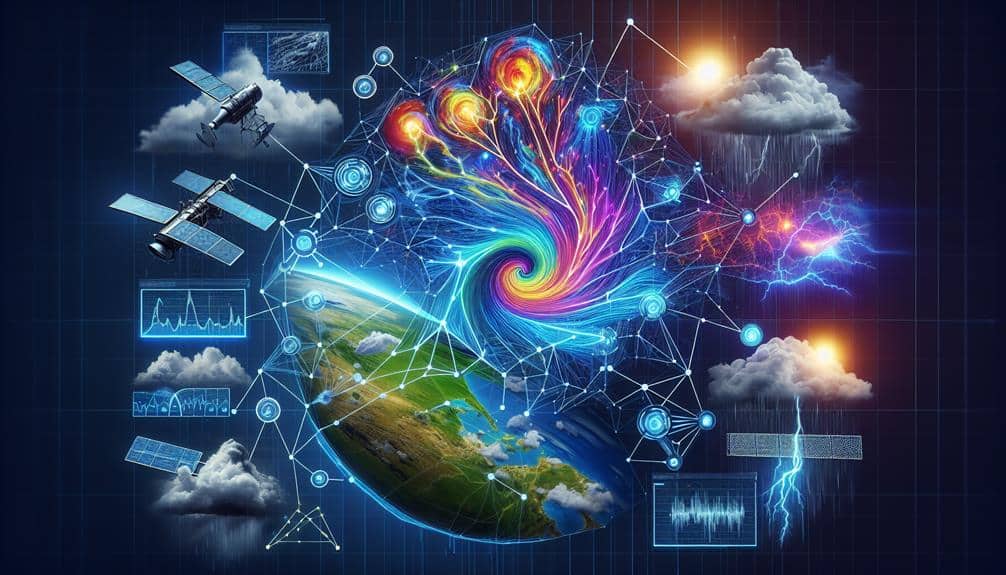For storm analysis, we depend on integrating various data fusion techniques to enhance forecasting accuracy. Satellite data integration provides high-resolution atmospheric monitoring, important for tracking storm formation and impact. Radar data fusion combines multiple observational sources, delivering detailed storm behavior insights. Numerical weather prediction (NWP) models simulate storm development, leveraging radar data for initial state accuracy. Ground-based observations offer precise real-time data, validating predictive models and enriching our understanding of storm dynamics. Additionally, advanced machine learning techniques refine forecasts through careful feature selection and robust model evaluation. These combined approaches greatly improve storm prediction capabilities, ensuring we're prepared for the next steps in our analysis.
Key Points
- Sensor fusion integrates data from multiple satellite sensors for high-resolution atmospheric monitoring.
- Radar data fusion merges radar data with other sources for detailed storm behavior analysis.
- Data assimilation in NWP models enhances forecasting accuracy by incorporating observational data.
- Ground-based observations validate models and provide real-time atmospheric measurements.
Satellite Data Integration
Integrating satellite data into storm analysis allows us to enhance the accuracy and timeliness of weather predictions. By leveraging advanced satellite imagery, we can monitor atmospheric conditions with high spatial and temporal resolution. This capability is essential for identifying storm formation, tracking its progress, and predicting its impact with greater precision.
One of the core techniques we use is sensor fusion, which combines data from multiple satellite sensors. These sensors capture various parameters such as cloud cover, sea surface temperatures, and wind speeds. By integrating this multispectral data, we can create a detailed picture of storm dynamics. Sensor fusion enables us to cross-verify data points, reducing uncertainties and increasing the reliability of our forecasts.
Satellite imagery also allows us to observe storm systems in real-time, providing vital insights into their development. For instance, high-resolution images of cloud patterns help us detect early signs of storm intensification. Additionally, thermal infrared sensors can measure temperature variations, offering clues about the storm's energy source and potential trajectory.
Radar Data Fusion
Integration of radar data with other observational sources greatly enhances our ability to analyze and predict storm behavior with high accuracy. By merging radar data, we capture detailed, real-time information about precipitation intensity, storm structure, and velocity. The application of advanced merging algorithms is essential to effectively combine this radar data with other datasets, such as satellite imagery, ground observations, and environmental sensors.
Our approach hinges on ensuring high data quality to maximize the reliability and precision of our storm analyses. We employ sophisticated merging algorithms that reconcile discrepancies between different data sources, filter out noise, and enhance the overall dataset. These algorithms enable us to create a more cohesive and all-encompassing picture of storm dynamics, which is vital for making timely and informed decisions.
High-quality radar data, when accurately merged with other observational sources, allows us to detect subtle changes in storm patterns and predict their evolution with greater confidence. This data-driven methodology empowers us to provide more accurate warnings and mitigate potential impacts on communities.
Ultimately, the merging of radar data not only enhances our analytical capabilities but also aligns with our commitment to leveraging the best available technology for storm analysis and prediction.
Numerical Weather Prediction
Building on the improved data quality from radar fusion, we utilize Numerical Weather Prediction (NWP) models to simulate and forecast storm development with high precision. These models integrate complex physical equations with observational data to predict atmospheric conditions.
By incorporating radar data, we can greatly enhance the model's initial state, a process known as data assimilation. This step is essential as it directly impacts the reliability of our forecasts.
One of the most effective techniques within NWP is ensemble forecasting. Rather than relying on a single deterministic forecast, we generate multiple simulations using slightly varied initial conditions. This method helps us quantify the uncertainty and range of possible storm scenarios.
By analyzing these ensembles, we gain a probabilistic understanding of storm development, which is invaluable for risk assessment and decision-making.
Data assimilation techniques further improve our forecasting capabilities by continuously updating NWP models with real-time observational data. This dynamic approach ensures that our predictions remain as precise as possible, even as new data becomes available.
Combining ensemble forecasting with robust data assimilation allows us to provide more dependable and timely storm forecasts, enabling greater preparedness and resilience in the face of severe weather events.
Ground-Based Observations
Frequently vital for accurate storm analysis, ground-based observations provide invaluable real-time data that complements and validates our NWP models. We depend on weather stations and sensor networks to collect precise measurements of atmospheric parameters such as temperature, humidity, wind speed, and pressure. These observations are crucial for refining our understanding of storm dynamics and improving the reliability of predictive models.
Weather stations, strategically located across various terrains, offer a detailed view of local weather conditions. Their data feeds directly into our models, enabling us to capture the nuances of storm formation and evolution. Sensor networks, often deployed in high-risk areas, enhance this capability by providing continuous, high-resolution data streams. These networks can detect rapid changes in weather conditions, offering early warnings that are essential for timely interventions.
Our integration of these ground-based observations with other data sources, like satellite imagery and radar, forms a robust multi-layered approach to storm analysis. This fusion not only improves forecast accuracy but also empowers us to make informed decisions that enhance public safety and resilience.
Machine Learning Techniques

Harnessing the rich data from ground-based observations, we now utilize advanced machine learning techniques to improve storm analysis and forecasting accuracy. The first step involves careful feature selection, ensuring that we capture the most relevant variables like wind speed, pressure, and humidity. By reducing dimensionality, we reduce noise and enhance model performance.
To achieve strong predictions, we utilize hyperparameter tuning. This process optimizes parameters such as learning rates and tree depths in algorithms like Random Forests or Gradient Boosting Machines. Through systematic experimentation, we identify the ideal configuration that yields the highest accuracy.
Cross validation is essential for evaluating our model's generalizability. By dividing our dataset into training and validation sets, we can thoroughly evaluate performance across different subsets. This method minimizes overfitting, ensuring our model performs well on unseen data.
Model evaluation metrics, such as precision, recall, and F1-score, provide detailed insights into our model's effectiveness. These metrics help us refine our approach and make data-driven decisions for continuous improvement.
Frequently Asked Questions
How Does Data Fusion Improve the Accuracy of Storm Forecasts?
Studies show a 20% improvement in storm forecast accuracy with data fusion. Data fusion benefits our predictions by integrating diverse data sources, enhancing accuracy improvement. This data integration refines storm forecast models, giving us more reliable and precise predictions.
What Are the Challenges in Combining Data From Different Sources?
We face challenges in data integration, primarily due to varying data quality across sources. Ensuring consistency and accuracy is challenging, but it's essential for reliable storm analysis. Effective integration enhances our predictive capabilities, granting us more freedom.
How Do You Validate the Reliability of Fused Data?
Imagine a hurricane prediction saving thousands. We validate fused data using validation methods like cross-validation and statistical analysis, ensuring accuracy. This rigorous approach empowers us to trust the data and make informed, life-saving decisions.
What Software Tools Are Commonly Used for Data Fusion in Meteorology?
For data integration in meteorology, we commonly use software tools like ArcGIS, MATLAB, and Python libraries such as Pandas and SciPy. These tools enable efficient, precise data fusion, empowering our analyses with thorough, accurate storm data.
Can Data Fusion Techniques Be Applied to Predict Other Natural Disasters?
With the precision of a seismograph, we can use data fusion techniques like machine learning for earthquake prediction and remote sensing for tsunami forecasting. These methods integrate diverse data sources for accurate, timely disaster predictions, empowering us with freedom.

